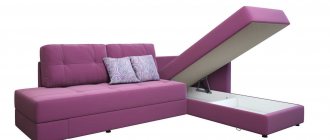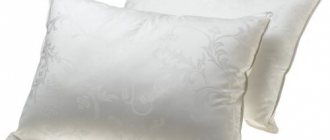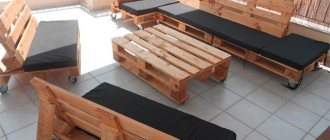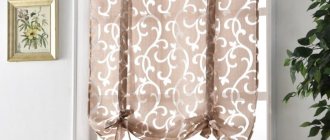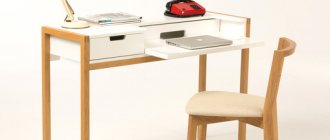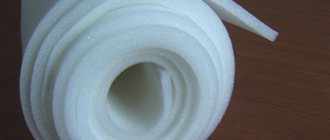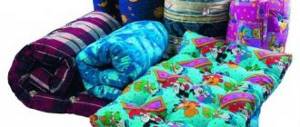Sheep and camel wool
Sheep and camel wool. These pillows are made from brushed wool. The filler has a natural crimp, which provides it with a long service life. High-quality wool does not cake and holds its shape well.
Main advantages of the filler:
- allows air to pass through well;
- resistant to moisture;
- does not retain heat;
- quickly takes the desired shape;
- serves for a long time.
- may cause an allergic reaction;
- There are fakes, in such cases the pillow very soon loses its shape;
- You cannot wash it yourself, you need to dry clean it regularly.
Natural latex
Natural latex. Elastic and at the same time soft material that has orthopedic properties. The filler is made from foam rubber (Givea resin).
Advantages:
- durability, the pillow can last up to twenty years;
- has bactericidal and hygienic properties;
- perfectly follows the contour of the head;
- high cost;
- The pillow is contraindicated for people with spine problems.
Orthopedic pillows do not cure. Only healthy people can sleep on them. For those who have problems with the cervical vertebra, this option is contraindicated.
Synthetic fillers
Despite their artificiality, synthetic fillers are becoming increasingly popular. They are much more profitable in terms of money, are less likely to cause allergic reactions, have a long shelf life and do not require special care.
Popular materials:
Sintepon
Sintepon. Soft, does not smell, is easy to wash and does not lose its shape. The only negative is that such a pillow lasts for at most two years.
Follofiber
Follofiber. The best substitute for down and feathers. Used to make orthopedic pillows. It is hypoallergenic, non-toxic, has good thermal insulation properties, does not absorb odors and does not retain moisture. Can be washed at home (water temperature - no higher than 40 degrees).
Comforel
Comforel. Little fluffy balls. It does not cause allergies, is cheap, has good air permeability and does not require special care.
Polyurethane
Synthetic foam - polyurethane (memory material). These pillows adapt perfectly to the shape of the body. They can be either soft or hard. Minus - they are not cheap, + they cannot be washed.
Before you make a choice
It is quite difficult to say unequivocally which pillow is better, since each person has his own needs.
Experts have compiled a wish list that can help you choose:
- Test it. Do not hesitate to smell the product in the store, try it by touch, and if possible, lie on a pillow.
- Evaluate the quality of the seams. The filler must not protrude outward; the seams must be secure.
- Pay special attention to the pillow cover. The one that is made from natural fabric (silk or cotton) is good.
- Buy a pillow that has a lock on the cover. This way you will have access to the filler - you will be able to evaluate the quality, and later wash it, add a new one, etc.
- Pay attention to the smell of the pillow. High-quality materials never smell of anything (with the exception of herbs, where the aroma, on the contrary, should be as rich as possible).
Don't be alarmed if you don't feel comfortable enough the first night after purchasing. This is completely normal as your body needs to get used to the new pillow.
The average adaptation period is three nights.
Where to find and buy an anti-stress pillow
Mnushki can be found in almost any gift store in Moscow and St. Petersburg, in the children's toy departments. Typically, such products have an original design and are pleasant to the touch, so they are often given as gifts, because they will delight any person. Manufacturers offer different shapes, colors and sizes. Children can be given in the form of a flower, a fish, a car, a ball, an animal; for adults, more practical ones: rollers, semicircular in shape under the neck for travel. You can find a large assortment and buy it in online stores. On average, a small product costs 300 rubles, a large one – about 1000 rubles. The price is affected by the complexity of the design and size.
So which filling is best for a blanket?
The cheapest fillings include cotton duvet filling. Among the advantages, it can be noted that it is warm and soft, but this does not cover its disadvantages, including the accumulation of dust, clumping and very noticeable weight. It is not recommended to cover children with them, because damp cotton wool can harbor parasites. They also cannot be washed, and you should be careful with dry cleaning, because it may leave stains on the filler.
The next most popular option is wool duvet filling. Among all the types of wool that serve as filler material, the most budget option is sheep's wool. It is distinguished by its ability to retain heat, despite its low weight, and create an optimal microclimate under the blanket. Camel wool is lighter than sheep's wool and noticeably stronger; its thermal properties are also superior to it. The most elite and luxurious option of wool fillings is cashmere. It is assembled by hand and in a very small volume, which affects the cost of the blanket.
In general, wool fillers are characterized by hygroscopicity, or moisture absorption, and the presence of lanolin - animal fat, which is responsible for the healing properties of wool and allergenicity.
(adsbygoogle = window.adsbygoogle || []).push({});
Another popular filling that claims to be the best for blankets is down. Its incredible lightness and warmth have already become a legend. Down filling quickly absorbs moisture, but dries slowly, which is one of its disadvantages. Down can also cause allergies and lead to dust mites. To ensure that the blanket does not lose its positive qualities, it must be dried and fluffed.
Bamboo blanket filling is distinguished by its ability to destroy harmful microorganisms that fall on its fibers. It also absorbs moisture well and keeps you warm. It is not without medicinal properties, because bamboo itself is distinguished by its ability to improve a person’s emotional state.
Silk filling for blankets is considered an elite among natural fillers; it does not cause an allergic reaction and does not accumulate dust. The filler made from it is soft and elastic, does not fall off and quickly evaporates moisture. The wear resistance and durability of a silk blanket can only be envied.
As for synthetic fillings for blankets, they definitely cannot be called the best fillings. Yes, they are hypoallergenic and in some properties they are superior to certain natural fillers: low weight and volume, easy care and durability. But they practically do not absorb moisture and do not provide the same air access as natural ones.
When choosing the best duvet filling, you should first of all decide why you are going to purchase a duvet. When choosing a baby blanket, you need to choose high-quality and expensive filling, because you cannot skimp on health. And when choosing a blanket for the cottage or for emergency situations, you can turn your attention to a synthetic filler, which takes up little space and can cope with its functions without difficulty.
Filler for children's products
Parents, when purchasing a bed for their children, are often concerned about which pillows they should buy and with what filling. Children's bedding must meet three conditions:
- hygiene;
- hypoallergenic;
- orthopedic effect.
Natural materials that fit these characteristics include fillings made of cotton wool, buckwheat husks, and sheep's wool. Hard, elastic cotton wool is useful for a six-month-old baby, and for an older child, we can recommend buckwheat husk filling. You just need to make sure that the rustling of the filler does not wake up the child or irritate him during sleep. Sheep wool with its therapeutic effect is not useful for every child, as it can cause an allergic reaction.
Today, experts increasingly recommend choosing synthetic materials as fillers for children’s pillows: padding polyester, holofiber, comforter. They are quite hard and elastic, hygienic, and do not attract dust along with pathogenic microorganisms. The low price allows you to regularly change the pillow for your child.
Which microfiller is the best?
Most of the best pillow fillings today are made from man-made materials. Down, feathers, wool, and cotton wool are dust accumulators; along with the dust, microorganisms that cause allergies settle in the pillow. Let's highlight those pillow fillings that are least affected by dust mites:
- buckwheat husk;
- latex;
- bamboo;
- silk;
- silicone;
- holofiber;
- Thinsulate
Silicone, holofiber, Comforel, Thinsulate are materials consisting of microscopic fibers that have similar properties. Let's find out which microfill for pillows to choose for each specific case.
- Silicone fiber is an inexpensive option for a product with an orthopedic effect, but this material is short-lived and the product will have to be changed frequently. Anyone who wants to purchase a pillow for the prevention of osteochondrosis can safely purchase a model with silicone filler.
- Products with holofiber are perhaps the most preferred choice for a wide range of people. Prevention of osteochondrosis, comfortable sleep, good quality and affordable price are the main advantages of these models.
- Anyone who has chronic diseases of the upper respiratory tract should pay attention to products filled with swan down (thinsulate).
DIY anti-stress pillows
You can make your own anti-stress massager.
For this you will need
- Elastic fabric. Look for as much lycra, elastane or nylon in the composition as possible, this will ensure that the material will stretch in any direction and not deform.
Pieces of fabric and felt for sewing a pillow
Decide what shape you want to give the fly. The easiest way is to make geometric shapes: a circle, a rectangle, a triangle; they will make an excellent smiley face, SpongeBob, or a bird from the computer game “Angry Birds”. You can also make simple patterns for any animal in the shape of a circle or square with ears. In general, show your imagination and involve your child! Children enjoy playing with bright and soft animals.
Owl pattern with a straight bottom for easy sewing of a zipper
Get to work.
- Start by preparing a drawing on paper, cut out this drawing and transfer it with chalk to the fabric. Don’t forget that you need to cut out 2 symmetrical sides from the fabric, retreating a couple of centimeters from the edge.
We trace the pattern on the wrong side of the fabric for the pillowcase and for the bedspread, leave seam allowances, cut out parts of the owl from both types of fabric
We cut out the eyes and nose from felt, lay them on and sew them on with a zigzag
We make eyelashes from artificial leather and glue them to the eyes
Finish the bottom cut of the fabric with an overlock or zigzag stitch, fold the edges inside out and attach one part of the zipper, covering the teeth halfway, then the other
Hidden fastener sewn into the pillow
We connect the parts with a straight stitch, folding them with their right sides inward
Turn it right side out
We sew on the legs of our owl, bend the edge, and stitch again
An item in which the child himself took part in sewing will always evoke pleasant memories.
We make a second pillowcase in a similar way, fill it with a special filler and get two anti-stress pillow toys
A case filled with granules is not a cure for nervous conditions, but it can help you relax a little and take your mind off things. In addition, you can’t look at soft stress toys without smiling; they lift your spirits just by looking at them.
Natural fillings for pillows
Natural fillers include:
- feather
- sheep or camel wool
- bamboo fiber
- wood-herbal fillers
- buckwheat husk, latex
Down and feather pillow
It is the most traditional and convenient item for our holiday. It is light, soft, warm, hygroscopic, and easily holds its shape.
Pillow filled with sheep or camel wool
It also retains heat well, and it is also beneficial for joint and muscle pain. One drawback of these pillows is that they are not suitable for asthmatics and allergy sufferers.
Pillows with buckwheat filling
Pillows filled with buckwheat have gained great popularity recently. Buckwheat hulls are absolutely hypoallergenic; these pillows hold their shape well and improve blood circulation. They give complete rest not only to the head, but to our entire body. The disadvantages of buckwheat pillows are rustling and weight.
Pillows filled with herbs and algae
Used as a remedy for insomnia and other sleep disorders. These pillows are used for a temporary therapeutic effect.
Natural latex filling
Such a filler as natural latex is strong, durable, and it also has antibacterial properties. Latex foam is produced by vulcanization from the sap of the Hevea tree. The porosity of latex ensures good air circulation during sleep. Natural latex is used mainly in orthopedic pillows.
Therapeutic effect of anti-stress pillows
The benefits and therapeutic effect of anti-stress pillows are not exaggerated. The product, even made in the form of a toy, can be used for sleep; it takes on the contours of the body and, by stimulating nerve endings, will help you relax.
A comfortable anti-stress travel pillow will help adults endure the trip calmly
It can be placed under the neck or lower back as a soft massager. The anti-stress effect is achieved by crushing the cover with granules with your hands. There are millions of nerve endings at the tips of a person’s fingers, which is why touching a soft mouse is so pleasant for the nerves. In addition, their rustling and quiet crunching calms a person, forcing him to listen to his feelings and, as a result, calm down. There is knitwear for covers with carbon threads; they have a positive effect on blood circulation in the brain and normalize blood pressure. Pregnant women can place an oblong-shaped product under their stomach, lying on their side, or under their legs to reduce swelling.
The therapeutic effect is achieved in the place affected by the pillow
